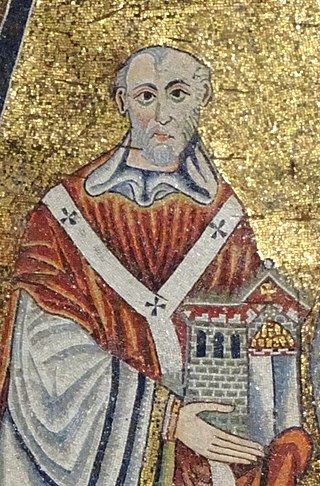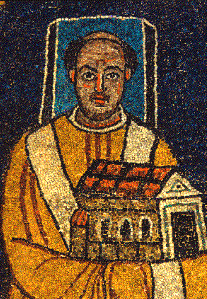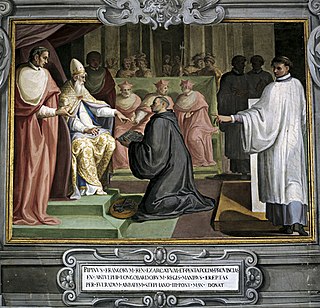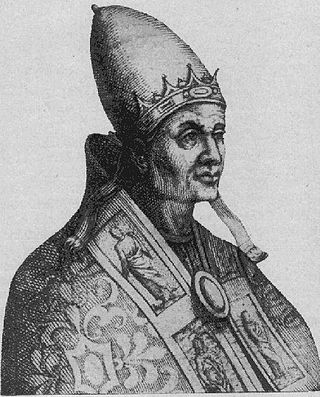Related Research Articles

Pope Honorius II, born Lamberto Scannabecchi, was head of the Catholic Church and ruler of the Papal States from 21 December 1124 to his death in 1130.
Pope Stephen IV was the bishop of Rome and ruler of the Papal States from June 816 to his death. Stephen belonged to a noble Roman family. In October 816, he crowned Louis the Pious as emperor at Reims, and persuaded him to release some Roman political prisoners he held in custody. He returned to Rome, by way of Ravenna, sometime in November and died the following January.

Pope Sergius I was the bishop of Rome from 15 December 687 to his death, and is revered as a saint by the Roman Catholic Church. He was elected at a time when two rivals, Paschal and Theodore, were locked in a dispute about which of them should become pope. His papacy was dominated by his response to the Quinisext Council, the canons of which he steadfastly refused to accept. Thereupon Emperor Justinian II ordered Sergius' arrest, but the Roman people and the Italian militia of the exarch of Ravenna refused to allow the exarch to bring Sergius to Constantinople.

Pope Innocent II, born Gregorio Papareschi, was head of the Catholic Church and ruler of the Papal States from 14 February 1130 to his death in 1143. His election as pope was controversial and the first eight years of his reign were marked by a struggle for recognition against the supporters of Anacletus II. He reached an understanding with King Lothair III of Germany who supported him against Anacletus and whom he crowned as Holy Roman emperor. Innocent went on to preside over the Second Lateran council.

Pope Paschal I was the bishop of Rome and ruler of the Papal States from 25 January 817 to his death in 824.
Pope John XIII was the bishop of Rome and ruler of the Papal States from 1 October 965 to his death. His pontificate was caught up in the continuing conflict between the Holy Roman emperor, Otto I, and the Roman nobility. After long and arduous negotiations, he succeeded in arranging a Byzantine marriage for Otto II, in an effort to legitimize the Ottonian claim to imperial dignity. He also established church hierarchy in Poland and Bohemia.
Anacletus II, born Pietro Pierleoni, was an antipope who ruled in opposition to Pope Innocent II from 1130 until his death in 1138. After the death of Pope Honorius II, the college of cardinals was divided over his successor. Unusually, the election was entrusted to eight cardinals, who elected Papareschi. A larger body of cardinals then elected Pierleoni, which led to a major schism in the Roman Catholic Church. Anacletus had the support of most Romans, including the Frangipani family, and Innocent was forced to flee to France. North of the Alps, Innocent gained the crucial support of the major religious orders, in particular Bernard of Clairvaux's Cistercians, the Abbot of Cluny Peter the Venerable; and Norbert of Xanten, the Archbishop of Magdeburg who established the Premonstratensians and held a high rank in the court of the German Emperor Lothar III.
Sylvester IV, born Maginulf, was a claimant to the Papacy from 1105 to 1111 in opposition to Paschal II. A priest before his election, he was probably a native of Rome. He had the backing of the Roman militia and initially of the Holy Roman Emperor, Henry IV, who later forced him to abdicate. Today he is regarded as an antipope.
Victor IV was an antipope for a short time, from March to 29 May 1138.
Teobaldo Boccapecci or Boccapeconai was elected pope after the death of Pope Callixtus II on 13 December 1124 and took the name Celestine II, but factional violence broke out during the investment ceremony and he resigned before being consecrated or enthroned in order to avoid schism.
GiordanoPierleoni was the son of the Consul Pier Leoni and therefore brother of Antipope Anacletus II and leader of the Commune of Rome which the people set up in 1143. According to Gregorovius, he was a “maverick” in the great Pierleoni family, for he continued to oppose the papacy after Anacletus' death, when the rest of his clan had returned to support of Rome.

The counts of Tusculum, also known as the Theophylacti, were a family of secular noblemen from Latium that maintained a powerful position in Rome between the 10th and 12th centuries. Several popes and antipopes during the 11th century came from their ranks. They created and perfected the political formula of noble-papacy, wherein the pope was arranged to be elected only from the ranks of the Roman nobles. The Pornocracy, the period of influence by powerful female courtesans of the family, also influenced papal history.
Pier Leoni was the son of the Jewish convert Leo de Benedicto and founder of the great and important medieval Roman family of the Pierleoni. He was called the Jewish Crassus by Gregorovius.
Leo de Benedicto Christiano, or just Benedictus Christianus, was a Jew of Trastevere in the late eleventh century. He converted to Christianity and was baptised by Pope Leo IX, whence he took his Christian name. He related himself to the ancient patrician families of Rome by the marrying of his daughters to powerful suitors. He himself was extremely rich.
Pietro Senex was Cardinal-Bishop of Porto from 1102 until his death. He was born probably in Rome.

From 756 to 857, the papacy shifted from the influence of the Byzantine Empire to that of the kings of the Franks. Pepin the Short, Charlemagne, and Louis the Pious had considerable influence in the selection and administration of popes. The "Donation of Pepin" (756) ratified a new period of papal rule in central Italy, which became known as the Papal States.

The Tusculan Papacy was a period of papal history from 1012 to 1048 where three successive relatives of the counts of Tusculum were installed as pope.
The 1124 papal election took place after the death of Pope Callixtus II on 13 December 1124. The election was characterised by a power struggle between Italian cardinals supported by the Pierleoni family and northern cardinals supported by the Frangipani family. On 16 December the cardinals elected Theobaldo Boccapecci, the cardinal-priest of Sant'Anastasia. He chose the name Celestine II. Before his consecration, however, an armed party of the Frangipani attacked and wounded the newly elected pope. In the following confusion the Bishop of Ostia Lamberto Scannabecchi, the Frangipani's candidate was proclaimed pope under the name Honorius II. After several days of factional fighting Celestine was abandoned by his supporters. However, Honorius would not accept the throne in this manner and resigned as well. He was immediately re-elected and consecrated on 21 December 1124.

The 1118 Papal Election was held to choose the successor for Pope Paschal II, who died in Rome on 21 January 1118, after an 18-year pontificate. Pope Gelasius II was elected as his successor. The election happened during the Investiture Controversy, a conflict between supporters of the Papacy and those of the Holy Roman Emperor. The election was held under the threat of possible violence due to the controversy. The Cardinal electors took refuge in the Benedictine monastery, S. Maria in Pallara, during the election. Within minutes of his election as pope, Gelasius II was attacked and imprisoned by the Frangipani faction, supporters of the Holy Roman Emperor. Gelasius managed to escape, but at the emperor's arrival with his army, he fled Rome and never returned.
Saxo de Anagnia was a Roman Catholic Cardinal, and Cardinal-priest of the titulus of S. Stefano al Monte Celio in Rome. He was a native of Anagni, and a member of the family of the Conti di Anagni. Dumas points out that there is no positive evidence of the family connection.
References
- Lanciani, Rodolfo A. New Tales of Ancient Rome (New York: Houghton, Mifflin & Co. 1902).
- Williams, George L. Papal Genealogy: The Families and Descendants of the Popes (Jefferson, NC: McFarland 2004).
- Robinson, I.S. (1990). The Papacy:1073-1190. Cambridge University Press.
- Mary Stroll, The Jewish Pope: Ideology and Politics in the Papal Schism of 1130 (New York: Brill Academic Pubs. 1987).